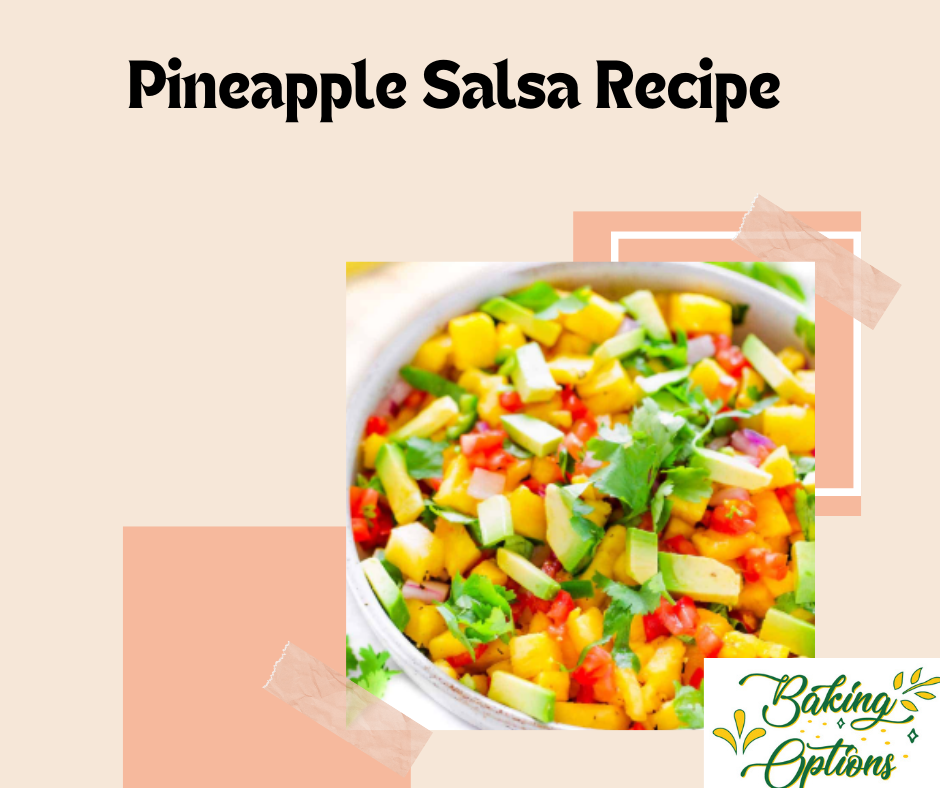The combination of pineapple salsa stands as my all-time best choice for two essential factors. The key ingredients required to create pineapples salsa are easily obtainable at common stores. The 8 components I will use for this recipe exist easily in stores.
The healthy qualities of this dish meet the requirement of excellent taste that leads people to eat it all with a single bite. This dish stands out because it offers busy individuals the best quick-cooking experience among complex meals.
Contents
Pineapple Salsa Ingredients
1 pineapple: Cleaned & cored
1 Medium Red Onion: Diced
1 Large Beefsteak Tomato: Diced
1 Red Bell Pepper: Diced
1 jalapeño: diced
¼ Bunch of Cilantro: Finely chopped
1 Lime: Juiced
Vegetable Oil
Salt and Freshly Ground Black Pepper
How to Make Pineapple Salsa Easily
I will make this tasty recipe in 6 easy steps. These steps are really simple; actually, I want to clear each step for easy understanding.
1. Pineapple preparation
Take a pineapple; clean it well. Then, remove the core, cut it into medium-sized pieces, and set it aside. We will use this later, but it’s important to prepare it first. Organizing ingredients in cooking is also part of this skill.
2. Dice Onion
Take a medium-sized onion & cut it into medium-sized pieces. Then, put it in another bowl. I recommend keeping it in cold water; this will reduce its sharpness.
3. Cut Tomato
After the onion, we will move on to the tomato. Take a large beefsteak tomato & cut it into medium-sized pieces. Put it in the bowl with the pineapple the bowl with the onion.
4. Chop the bell pepper
First, get one red bell pepper; however, cut off the seeds and the ribs, and then chop the bell pepper into medium size. Squeeze this on the pineapple & add it to the bowl.
5. Add Jalapeño for Spice & Cilantro
Use one jalapeño and remove the seeds, although if you would like a bit of spiciness, just leave the seeds whole but chopped small. Put it in the bowl of the other vegetables served before it.
Then, choose a quarter of cilantro and chop it finely, but do not chop it too finely so that the oils move onto the chopping board.
6. Mix Ingredients & Adjust
Take one lime and press it over the pineapple salsa mixture. Then, ensure that you add some vegetable oil, and then sprinkle with some salt and fresh ground black pepper and mix everything well.
Give it a try! If you feel that it requires more lime, add a few more drops of lime juice, and add a little more salt if you desire as well.
Chill Before Serving
Spoon the salsa into the refrigerator for around one hour to cool down before taking it as a meal.
Leftover Salsa Storing Tips
Choose The Right Container
Choosing a tight container beforehand is very important because selecting the wrong one can spoil the salsa.
Look for
- Stainless steel containers that may not allow any air into them at all.
- Glass or food-grade transparent polyethylene terephthalate (PET) containers
- Containers free of food remains and are clean and dry
Proper containment is the first line of protection against bacterial growth and loss of flavor. A suitable container protects the salsa by ensuring it does not take the smells of other food items within the refrigerator.
Refrigeration Guidelines
Your pineapple salsa has a comparably short but very nice shelf life. Here’s what you need to know:
- Maximum Refrigerator Storage: 3-5 days
- Peak Freshness Window: First 24-48 hours
- Ideal Temperature: 40°F (4°C) or below
Tip: Refrigerate the salsa and try to place it in the most chilled area of your refrigerator, which is the bottom rear section. If passed over, it helps to maintain the right temperature and keeps the salsa packed with fresh vegetables and fruits.
Ingredient Considerations
Different components of your pineapple salsa affect its storage life:
- As I told you, fresh pineapple disintegrates much quicker.
- Onions and cilantro would spoil within a day when washed.
- Peppers keep their crunch for 2-3 days.
The finely chopped and well-mixed vegetables that go into a salsa recipe give it a relatively short shelf life, so the salsa tastes best when consumed immediately after preparation. Next, the flavors will not be as vibrant as on the first try and will change daily.
Warning Signs When Pineapple Salsa Goes Bad
Because this recipe has a high chance of spoiling quickly, let me share some signs so that you can immediately know and not consume it if it happens to you.
- Unusual or sour smell
- Visible mold growth
- Liquid separation
- Significant color changes
- The slimy or mushy texture
Some Practical Tips
- When serving food, ensure that the utensils you use are clean.
- Another instructive eating pointer recommended that the salsa be stirred before every use to help distribute the ingredients.
- Salsa should be kept at room temperature for at most 2 hours.
Pineapple Salsa: Common Mistakes & Their Solutions
Overmixing Ingredients
The correct selection of salsa components seems straight forward yet an improper handling of food texture may damage a perfectly good salsa.
Rough handling of food before mixing it will result in damaged cells of fresh ingredients including pineapple, onions and peppers.
What happens when you overmix:
- Ingredients become mushy.
- Lose their crisp texture.
- Make it less visually appealing with a soft and wet feel.
How to mix correctly:
- For more precise cuts, you should ensure that you are using a sharp knife.
- To make sure that the ingredients are even cooked, mixed ingredients should be chopped into equal sizes.
- Fold ingredients gently.
- Avoid using food processors.
- Blend softly—because we want pieces, not a mash.
Flavor Balancing Issues
Another frequent mistake is failing to balance the flavors in your salsa. Pineapple is naturally sweet & acidic, so it is important to adjust other ingredients.
If you add too much lime juice or salt without tasting, your salsa may become overly acidic or salty. To gain balance, taste frequently and start with small amounts of lime juice and salt, adjusting as needed.
If it’s too acidic, a pinch of sugar can help; if it’s too sweet, add more lime juice.
Quick Related FAQs
How to Pick a Ripe Pineapple?
Choose a pineapple by gently pressing it which should yield to pressure and also checking the bottom for a sweet aroma. Choose pineapples with solid green leaves combined with a soft and healthy leaf appearance.
The storage duration of pineapple salsa in the refrigerator amounts to three to five days.
A sealed container enables pineapple salsa to remain refrigerated between 3 to 5 days.
Can You Freeze Pineapple Salsa?
Freezing pineapple salsa is possible although freezing will change the salsa texture. According to experts the texture will experience modifications when you defrost it. Consuming frozen pineapple salsa works best during the 2 to 3 months period after freezing.
Seeds Obligation for Jalapeños during Preparation Process.
Jalapeño salsa becomes less spicy when all seeds are removed from the peppers. The decision to retain seeds determines the final spiciness of the salsa.
Must Give It a Try
With easy and simple steps. A simple pineapple salsa worked quickly offers both chip hunger prevention and fish and pork side tastes while acting as a taco topping.
Fresh pineapple pieces should be medium-sized then mix them with red onion, beefsteak tomato, red bell pepper and jalapeño.
One complete ingredient list includes cilantro alongside lime juice which creates the signature tangy taste. The mixture requires salt and pepper to taste for seasoning. Check the flavors before serving as you can always increase the amount of lime or salt to your preference. Set the mixture to cool in the refrigerator during an hour to enhance its taste.

